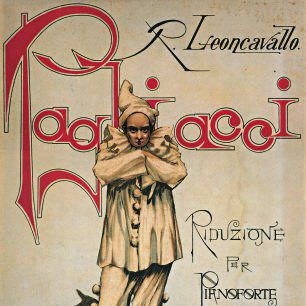
Overview
Synopsis
A dramatic tale of love and betrayal, Pagliacci revolves around a commedia dell'arte troupe. Canio and Nedda are married, and the leads in the troupe along with Tonio and Beppe, however Nedda is secretly having an affair with Silvio.
Fearing Canio’s anger, Nedda continues to hide the affair, and even goes as far to attempt to break it off with Silvio. Silvio and Nedda’s love is strong, however, and they plan to run away together. Tonio, also in love with Nedda, confesses his love for her, but she turns him away, shaming him. In an act of revenge, Tonio tells Canio that Nedda is having an affair like he suspected.
During a performance, Canio confronts Nedda, and stabs her. Silvio attempts to save Nedda, running up on stage, but gets stabbed by Canio as well. The audience, not realizing it was real, claps until Canio screams at them, “the comedy is ended.”
Show Information
Context
Leoncavallo was inspired to write Pagliacci after recalling a memory from his childhood, in which there was a murder of family servant. The woman was murdered by two brothers who were both in love with the girl. Leoncavallo’s father, a judge, presided over the investigation.
Leoncavallo was accused of plagiarism, however, by a French author who thought that it resembled a play that he wrote too closely. Even though Pagliacci received mixed reviews from the critics, the audiences loved it
to read the context for Pagliacci and to unlock other amazing theatre resources!Plot
In the prologue before the opera begins, the clown, Tonio, speaks directly to the audience. Tonio says that this author has written the story about actors, who feel the same feelings as regular people (Si può? Si può).
Act I
The villagers walk around in town as a small traveling theatrical company arrives into the Calabrian town. Canio is the head of the acting troupe, announcing to the villagers what they will perform that night. Someone calls out, joking that
to read the plot for Pagliacci and to unlock other amazing theatre resources!Characters
| Name | Part Size | Gender | Vocal Part |
|---|---|---|---|
|
Lead |
Male |
Tenor |
|
|
Lead |
Female |
Soprano |
|
|
Supporting |
Male |
Baritone |
|
|
Supporting |
Male |
Tenor |
|
|
Supporting |
Male |
Baritone |
|
|
Ensemble |
Either Gender |
Soprano, Mezzo-Soprano, Contralto, Tenor, Bass, Baritone |
Songs
Act I Prologue:
Scene I:
- Chorus: Son qua! (Chorus)
- Cantabile: Un tal gioco (Canio)
- Scena and Chorus of the Bells: I zampognari
Scene II:
- Andate con moto: Qual fiamma avea nel guardo (Nedda)
- Ballatella: Hui! Hui!... Stridono lassù (Nedda)
- Scena and Duet: Sei là? (Nedda, Tonio)
Scene III:
- Duet: Silvio! a quest’ora… (Nedda, Silvio)
Scene IV:
- Scena and Finale: Cammina adagio (Tonio, Canio)
- Arioso: Vesti la giubba (Canio)
Act II
Scene I:
- Chorus: Presto affrettiamoci (Chorus)
Scene II:
- Commedia: Pagliaccio, mio marito (Nedda [Colombina])
- Serenata: O Colombina, il tenero fido Arlecchin (Beppe [Arlecchino])
- Scene Comica: Dei, come e bella! (Nedda [Colombina], Tonio [Taddeo])
- Duet: Arlecchin! (Nedda [Colombina], Beppe [Arlecchino])
- Final Scena and Duet: Versa il filtro (Nedda, Canio)
A song with an asterisk (*) before the title indicates a dance number; a character listed in a song with an asterisk (*) by the character's name indicates that the character exclusively serves as a dancer in this song, which is sung by other characters.
Monologues
Scenes
Key Terms
Sorry! We do not currently have terms for this guide.
Videos
Quizzes
Themes, Symbols & Motifs
Sorry! We do not currently have learning modules for this guide.
Quote Analysis
Sorry! We do not currently have learning modules for this guide.
